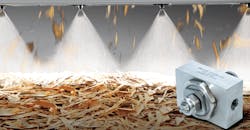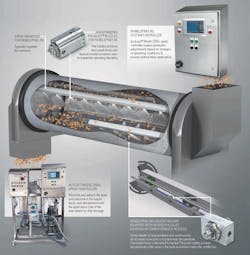No two spraying applications are ever identical. Whether you're after humidity control or lubrication, precision adhesive applications or smooth chocolate coatings, every job and every material presents different challenges and engineering hurdles to overcome.
Some of these challenges, however, are a bit trickier than others.
Take that chocolate coating example. To coat, say, a peanut evenly, you have to first develop a system to roll, move, or float every nut 360 deg in a controlled, repeatable manner. Then you have to find a system that is capable of spraying thick, molten chocolate while also keeping that chocolate hot (but not too hot) all the way to the tip of the nozzle.
That's a rather tall order. But Spraying Systems Co.—an expert in particularly difficult precision spraying applications like these—also addresses an even steeper challenge: engineered wood.
Engineering Wood
To an outsider, the particle boards you pass at Home Depot or handle on a construction project may not seem overly complicated. But trust me, they are. Check out Spraying Systems Co.'s video on the process:
The Solution
Spraying Systems Co.'s answer to this challenge is a line called the PanelSpray System, which was featured in the video above. The system brings in all of the heavy-hitters from the company's spraying lineup. It includes Precision Spray Control to ensure consistent, uniform fluid application, plus an AutoJet spray controller and electrically-actuated PulsaJet nozzles to precisely control flow rate. Together, these system components cut waste and ensure that every drop of glue and wax go exactly where they are meant to go, even if operating conditions change (so no need for the jackhammers). If the line speeds up, the spraying system accommodates; if it slows, it follows without changing the drop size or flow rate. And the final system is a work of art.Cutting out even a fraction of that waste will have a significant impact on costs—let alone safety.
Learn more about the PanelSpray system on the NED Directory.
"For customers using millions of dollars' worth of resin per year making these boards, saving even a small percentage of the coating is a big deal," he says. "That means the payback can be pretty quick, even on a significant capital investment."
But savings aside, he argues, this solution offers its users some significant benefits that few others have offered before.
"They can improve production based on less downtime," he says. "We can allow them to run faster while improving overall board quality."
About the Author
Travis Hessman
VP of Content, Endeavor Business Media
Travis Hessman is the VP of Content for Endeavor Business Media. Previously, Travis was the Editor-in-Chief for Industry Week and New Equipment Digest as well as the Group Editorial Director for Endeavor's Manufacturing Group.
He began his career as an intern at IndustryWeek in 2001 and later served as IW's technology and innovation editor. Today, he combines his experience as an educator, a writer, and a journalist to help address some of the most significant challenges in the manufacturing industry, with a particular focus on leadership, training, and the technologies of smart manufacturing.


